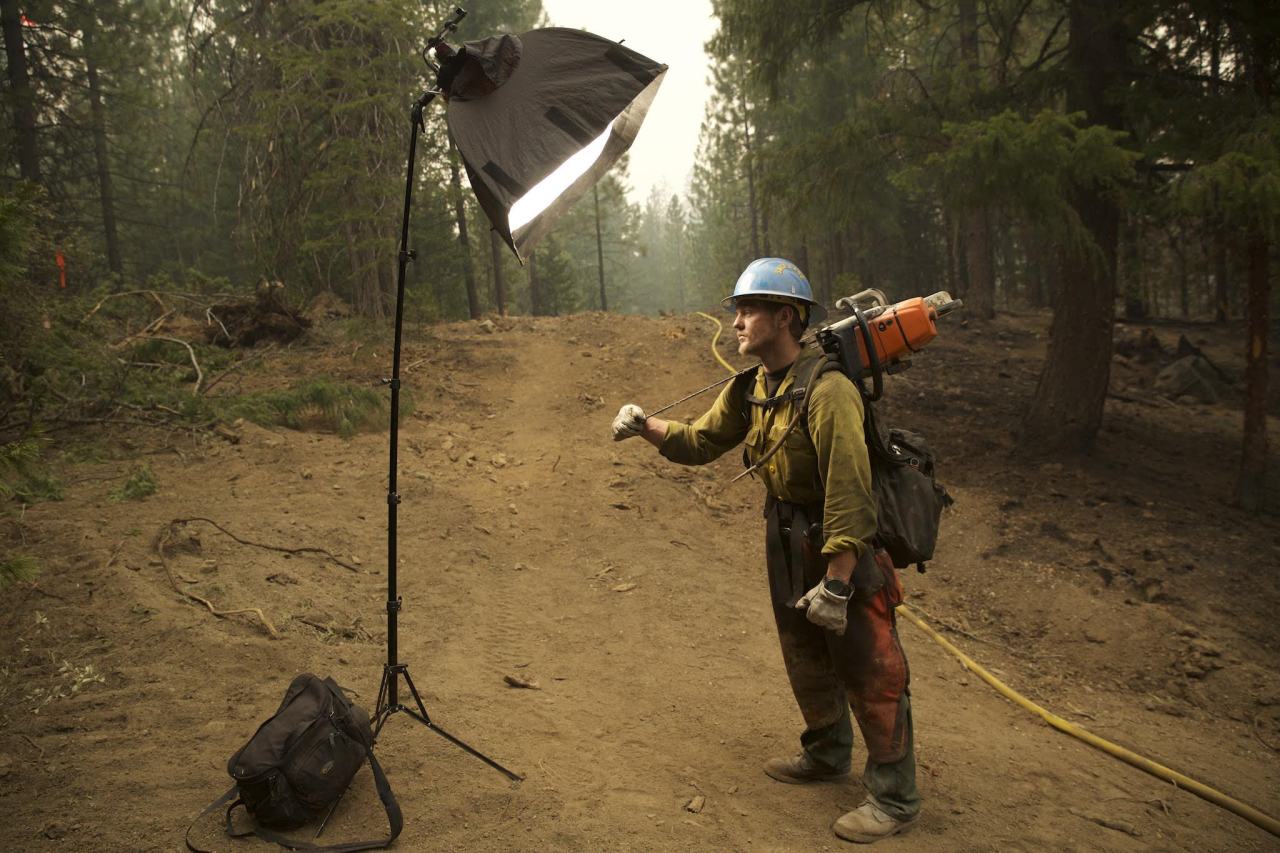No doubt the National Geographic website is one of the most generous when it comes to sharing photographies. Through these pictures, we dream, travel and learn. Today, we share with you an article from Mark Thiessen, photographer with National Geographic, who shows us there’s no need to make complex scenarios to create wonderful pictures!
During the 20 years I have been shooting wildfires there is one thing that always stands out: the faces. They have that “50-foot stare in a 10-foot room” gaze. Who could blame them after working 21 days straight? A few weeks ago I spent a week with a hand crew from the Salt Lake Unified Fire Authority.
(See the story on Nat Geo News, A Photographer Inside the Wildfires )Although they usually work 14 days, they were extended to 21 because it was such a frantic fire season. Three weeks of hard work in hot, dusty, smoky conditions—combined with accumulated sleep deprivation—can really take its toll, and it shows on their faces. Here’s how I capture these portraits on the fire line.
First I look for a background that has some depth and the residual smoke of a burned-out area helps with this effect. Next I set up a soft box with a
Canon Speedlite 600-EX-RT strobe inside. This is the same kind of strobe you would place on top of your camera, but I’m putting it in a
softbox. For those who don’t know, a softbox is kind of like a tent that diffuses the light. The larger the softbox, the softer the light. I placed the softbox on a light stand pointing at the subject and shot below it. I make several test shots and adjust the strobe so the light falling on the subject balances with the ambient light falling on the background.
Although I’m using a 24-70mm zoom lens, I prefer to back off and zoom in to avoid wide-angle distortion. I also set my aperture at f/4 for shallow depth of field. I want the background to go out of focus. I don’t really pose them. I draw a line in the dirt with my foot and tell them to stand just behind it. Depending on the person, a firefighter will stand very straight and rigid. In this case I just ask them to shift their weight from one foot to another. I shoot them loose, tight, and tight horizontal portraits.
Time is of the essence so I don’t shoot more than a few of each composition. I try to select a spot where I’m away from the rest of the fire crew. They are tight like family and love to tease the person being photographed.
As you can tell, there’s a lot that comes together to make these portraits. But in the end it is simply these firefighters that carry the day.


![Capturing Portraits on the Fire LineNational Geographic photographer Mark Thiessen is our inside man when it comes to stories about fire. He has photographed several wildfire stories and is a trained firefighter himself. Recently, he embedded with one team fighting a group of fires near Hayfork, California. Go to our sister blog Proof to see all the portraits and read his first-person account about working with the firefighting crew.
During the 20 years I have been shooting wildfires there is one thing that always stands out: the faces. They have that “50-foot stare in a 10-foot room” gaze. Who could blame them after working 21 days straight? A few weeks ago I spent a week with a hand crew from the Salt Lake Unified Fire Authority. (See the story on Nat Geo News, A Photographer Inside the Wildfires ) Although they usually work 14 days, they were extended to 21 because it was such a frantic fire season. Three weeks of hard work in hot, dusty, smoky conditions—combined with accumulated sleep deprivation—can really take its toll, and it shows on their faces.Here’s how I capture these portraits on the fire line. First I look for a background that has some depth and the residual smoke of a burned-out area helps with this effect. Next I set up a soft box with a Canon Speedlite 600-EX-RT strobe inside. This is the same kind of strobe you would place on top of your camera, but I’m putting it in a softbox. For those who don’t know, a softbox is kind of like a tent that diffuses the light. The larger the softbox, the softer the light. I placed the softbox on a light stand pointing at the subject and shot below it.[[MORE]]I make several test shots and adjust the strobe so the light falling on the subject balances with the ambient light falling on the background. Although I’m using a 24-70mm zoom lens, I prefer to back off and zoom in to avoid wide-angle distortion. I also set my aperture at f/4 for shallow depth of field. I want the background to go out of focus. I don’t really pose them. I draw a line in the dirt with my foot and tell them to stand just behind it. Depending on the person, a firefighter will stand very straight and rigid. In this case I just ask them to shift their weight from one foot to another. I shoot them loose, tight, and tight horizontal portraits. Time is of the essence so I don’t shoot more than a few of each composition.I try to select a spot where I’m away from the rest of the fire crew. They are tight like family and love to tease the person being photographed. As you can tell, there’s a lot that comes together to make these portraits. But in the end it is simply these firefighters that carry the day.– Mark Thiessen, National Geographic Photographer Click here to see wildfire photos from the Your Shot community.](http://36.media.tumblr.com/fab40d305233f927e95dc4acc82e2318/tumblr_ntt1wml9O21riijaro4_1280.jpg)
![Capturing Portraits on the Fire LineNational Geographic photographer Mark Thiessen is our inside man when it comes to stories about fire. He has photographed several wildfire stories and is a trained firefighter himself. Recently, he embedded with one team fighting a group of fires near Hayfork, California. Go to our sister blog Proof to see all the portraits and read his first-person account about working with the firefighting crew.
During the 20 years I have been shooting wildfires there is one thing that always stands out: the faces. They have that “50-foot stare in a 10-foot room” gaze. Who could blame them after working 21 days straight? A few weeks ago I spent a week with a hand crew from the Salt Lake Unified Fire Authority. (See the story on Nat Geo News, A Photographer Inside the Wildfires ) Although they usually work 14 days, they were extended to 21 because it was such a frantic fire season. Three weeks of hard work in hot, dusty, smoky conditions—combined with accumulated sleep deprivation—can really take its toll, and it shows on their faces.Here’s how I capture these portraits on the fire line. First I look for a background that has some depth and the residual smoke of a burned-out area helps with this effect. Next I set up a soft box with a Canon Speedlite 600-EX-RT strobe inside. This is the same kind of strobe you would place on top of your camera, but I’m putting it in a softbox. For those who don’t know, a softbox is kind of like a tent that diffuses the light. The larger the softbox, the softer the light. I placed the softbox on a light stand pointing at the subject and shot below it.[[MORE]]I make several test shots and adjust the strobe so the light falling on the subject balances with the ambient light falling on the background. Although I’m using a 24-70mm zoom lens, I prefer to back off and zoom in to avoid wide-angle distortion. I also set my aperture at f/4 for shallow depth of field. I want the background to go out of focus. I don’t really pose them. I draw a line in the dirt with my foot and tell them to stand just behind it. Depending on the person, a firefighter will stand very straight and rigid. In this case I just ask them to shift their weight from one foot to another. I shoot them loose, tight, and tight horizontal portraits. Time is of the essence so I don’t shoot more than a few of each composition.I try to select a spot where I’m away from the rest of the fire crew. They are tight like family and love to tease the person being photographed. As you can tell, there’s a lot that comes together to make these portraits. But in the end it is simply these firefighters that carry the day.– Mark Thiessen, National Geographic Photographer Click here to see wildfire photos from the Your Shot community.](http://40.media.tumblr.com/eaa6cc6b2cfda3bc4b093aa23cdd032f/tumblr_ntt1wml9O21riijaro1_1280.jpg)
![Capturing Portraits on the Fire LineNational Geographic photographer Mark Thiessen is our inside man when it comes to stories about fire. He has photographed several wildfire stories and is a trained firefighter himself. Recently, he embedded with one team fighting a group of fires near Hayfork, California. Go to our sister blog Proof to see all the portraits and read his first-person account about working with the firefighting crew.
During the 20 years I have been shooting wildfires there is one thing that always stands out: the faces. They have that “50-foot stare in a 10-foot room” gaze. Who could blame them after working 21 days straight? A few weeks ago I spent a week with a hand crew from the Salt Lake Unified Fire Authority. (See the story on Nat Geo News, A Photographer Inside the Wildfires ) Although they usually work 14 days, they were extended to 21 because it was such a frantic fire season. Three weeks of hard work in hot, dusty, smoky conditions—combined with accumulated sleep deprivation—can really take its toll, and it shows on their faces.Here’s how I capture these portraits on the fire line. First I look for a background that has some depth and the residual smoke of a burned-out area helps with this effect. Next I set up a soft box with a Canon Speedlite 600-EX-RT strobe inside. This is the same kind of strobe you would place on top of your camera, but I’m putting it in a softbox. For those who don’t know, a softbox is kind of like a tent that diffuses the light. The larger the softbox, the softer the light. I placed the softbox on a light stand pointing at the subject and shot below it.[[MORE]]I make several test shots and adjust the strobe so the light falling on the subject balances with the ambient light falling on the background. Although I’m using a 24-70mm zoom lens, I prefer to back off and zoom in to avoid wide-angle distortion. I also set my aperture at f/4 for shallow depth of field. I want the background to go out of focus. I don’t really pose them. I draw a line in the dirt with my foot and tell them to stand just behind it. Depending on the person, a firefighter will stand very straight and rigid. In this case I just ask them to shift their weight from one foot to another. I shoot them loose, tight, and tight horizontal portraits. Time is of the essence so I don’t shoot more than a few of each composition.I try to select a spot where I’m away from the rest of the fire crew. They are tight like family and love to tease the person being photographed. As you can tell, there’s a lot that comes together to make these portraits. But in the end it is simply these firefighters that carry the day.– Mark Thiessen, National Geographic Photographer Click here to see wildfire photos from the Your Shot community.](http://40.media.tumblr.com/bf79f397297c795959f680333a78e0e8/tumblr_ntt1wml9O21riijaro2_1280.jpg)